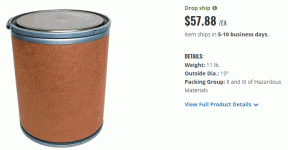egbell,
Grounding: Here is my understanding of static electricity and “grounding” PVC.
PVC cannot be grounded since PVC is not electrically conductive. Thus static charges build up on the pipe. If a path to ground is available, static charges near the ground can be dissipated but elsewhere static charges remain. When enough static build up exists, a static discharge can occur; some may be of low energy while others of a high energy. The higher energy discharges can offer enough energy to ignite an explosion.
The second and third requirements for an explosion are fuel and oxygen. Generally the ratio of dust to oxygen must be within a lower and upper range to trigger an explosion. While I do not know what this ratio is for wood dust, it seems to be such that it rarely causes an explosion in a home workshop; at least I am unaware of any.
I elected to mitigate static charge build up on the PVC for several reasons: 1) reduce the likelihood of an energetic discharge, 2) to reduce fine dust build-up on the outside of the pipes, 3) eliminate the occasional annoying static shock.
There are two approaches of which I am aware that can be used to reduce statistic discharges from PVC. The effectiveness in gathering surface static charges seems to depend on the amount of pipe in contact with the grounded conductive material.
The first approach is wrapping the PVC pipe with bare wire (usually copper) that is then terminated to ground. The closer the wrapped wire is as it encircles the pipe the greater its ability to collect static charge from the pipe. Some recommend or even have installed a wire inside the pipe.
The second approach is to install electrically foil tape on the pipe terminated to ground. I took the inside/outside foil tape approach. I chose to install foil tape inside and outside the pipe to increase the surface area where static surface charge could collect and be sent to ground. The two strips of 4” wide foil tape covered about 40% of the surface area of the 6” pipe.
My foil tape approach meets neither of your criteria. It was expensive for the 60 feet of pipe I installed. It was also time consuming, especially installing the tape inside the pipe. The cost would have been reduced by 50% and the effort greatly reduced if foil tape was installed only on the outside of the pipe.
Any material inside the pipe can increase static pressure and adversely affect the vortex inside the pipe by creating zones of turbulence. Therefore, I tried to avoid pipe penetrations including screw tips. I also doubt that screw tips inside a pipe would be very effective for overall static charge mitigation.
Here is an article that may be of interest entitled “Grounding PVC and Other Dust Collection Myths”.
http://www.woodcentral.com/articles/shop/articles_221.shtml

